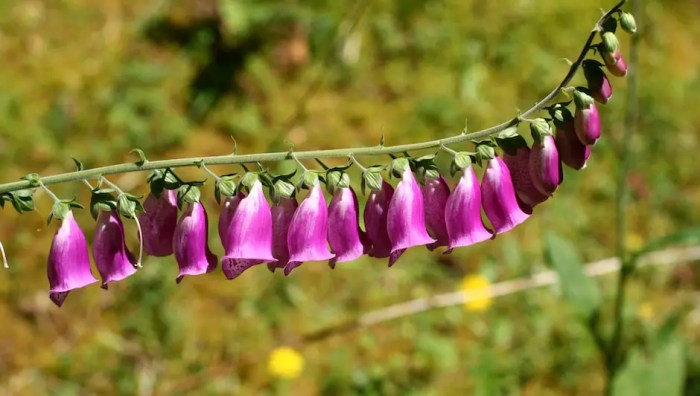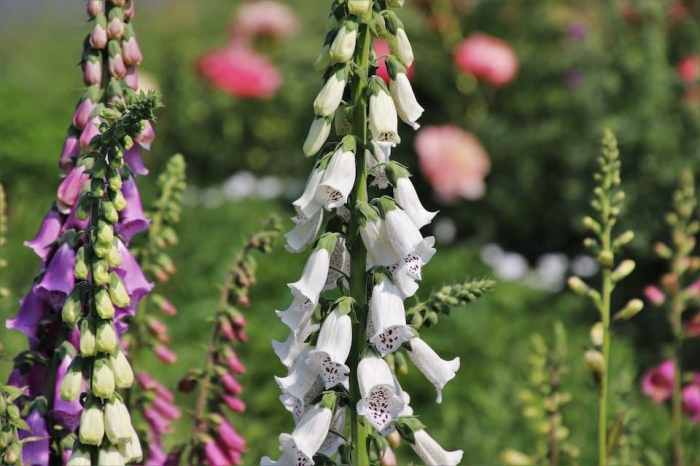How to Plant Foxglove Seeds
Growing Foxgloves from Seed

Source: smallspacegardeningbasics.com
How to plant foxglove seeds – Foxgloves, with their elegant spires of bell-shaped flowers, are a rewarding addition to any garden. Propagating them from seed offers a cost-effective and enjoyable way to cultivate these stunning plants. This guide details both indoor seed starting and direct sowing methods, along with comprehensive care instructions to ensure successful foxglove cultivation.
Indoor Seed Starting

Source: sandiegoseedcompany.com
Starting foxglove seeds indoors provides a head start, especially in cooler climates, allowing for earlier blooms. This method offers greater control over germination conditions and protects seedlings from harsh weather.
Ideal Germination Conditions: Foxglove seeds require specific conditions for optimal germination. A temperature range of 65-70°F (18-21°C) is ideal. They need bright, indirect light; direct sunlight can scorch delicate seedlings. Consistent moisture is crucial, but avoid soggy soil which can lead to damping-off.
Sowing Foxglove Seeds: Use seed trays filled with a well-draining seed starting mix. Sow seeds thinly and evenly onto the surface, gently pressing them into the soil. Do not cover them deeply; light is essential for germination. Lightly mist the soil with water and cover the tray with clear plastic wrap or a humidity dome to maintain moisture.
Maintaining Moisture: Regularly check the moisture level and mist as needed to prevent the soil from drying out completely. Avoid overwatering, which can lead to fungal diseases. Good air circulation is important; vent the plastic wrap or dome periodically.
| Seed Starting Mix | Composition | Drainage | Pros |
|---|---|---|---|
| Coco Coir-based Mix | Coco coir, perlite, vermiculite | Excellent | Lightweight, holds moisture well, good aeration |
| Peat-based Mix | Peat moss, perlite, vermiculite | Good | Readily available, inexpensive |
| Seed Starting Mix (Commercial) | Variable, check label | Varies | Convenient, formulated for seed germination |
| Soilless Mix | Perlite, vermiculite, composted bark | Excellent | Sterile, good drainage and aeration |
Direct Sowing Outdoors
Direct sowing offers a simpler approach, eliminating the need for transplanting. However, success depends on favorable weather conditions and timing.
Timing: Sow foxglove seeds outdoors after the last expected frost when soil temperatures have warmed to at least 60°F (15°C). This typically falls in spring or early summer, depending on your climate.
Soil Preparation: Choose a location with well-drained soil that is rich in organic matter. Amend heavy clay soils with compost or other organic materials to improve drainage. Loosen the soil to a depth of about 6 inches (15 cm) before sowing.
Sowing Method: Scatter seeds thinly and evenly over the prepared soil surface. Lightly rake them into the soil to a depth of about ¼ inch (0.6 cm). Gently firm the soil around the seeds.
- Challenge: Slugs and snails can devour seedlings. Mitigation: Use slug bait or create barriers around the planting area.
- Challenge: Irregular germination due to fluctuating soil temperatures. Mitigation: Choose a location with consistent moisture and shade during the hottest part of the day.
- Challenge: Weed competition. Mitigation: Mulch around the seedlings to suppress weeds.
Seedling Care

Source: flowermag.com
Providing appropriate care for foxglove seedlings is crucial for healthy growth and abundant flowering. This includes consistent watering, fertilization, and pest control.
Watering and Fertilizing: Keep the soil consistently moist, but not waterlogged. Fertilize seedlings lightly every 2-3 weeks with a balanced liquid fertilizer once they develop their first true leaves.
Transplanting Schedule: Transplant seedlings from seed trays into individual pots when they have developed 2-3 sets of true leaves. Once they reach 4-6 inches (10-15 cm) tall, they can be transplanted to their final location in the garden.
Common Problems and Solutions: Damping-off (fungal disease) can affect seedlings. Ensure good air circulation and avoid overwatering. Aphids and other pests may also infest seedlings. Use insecticidal soap or neem oil to control them.
Hardening Off: Before transplanting outdoors, gradually acclimate seedlings to outdoor conditions over 7-10 days. Start by placing them in a sheltered location for a few hours each day, gradually increasing the exposure time.
Choosing a Location and Soil, How to plant foxglove seeds
Selecting the right location and preparing the soil are vital steps for successful foxglove cultivation. Foxgloves thrive in well-drained soil with sufficient sunlight.
Ideal Soil Conditions: Foxgloves prefer slightly acidic to neutral soil (pH 6.0-7.0) with good drainage. Amend heavy clay soils with organic matter to improve drainage and aeration.
Planting foxglove seeds requires a bit of patience, as they need light to germinate. For best results, sow them on the surface of moist soil and keep them consistently damp. If you’re looking for a faster, more predictable indoor germination experience, you might find helpful advice on how to plant basil seeds indoors , which shares similar techniques for starting seeds.
Applying these principles to foxgloves, remember to maintain consistent moisture levels for successful sprouting.
Sunlight Exposure: Foxgloves need at least 4-6 hours of sunlight per day. However, afternoon shade in hot climates is beneficial to prevent scorching.
Site Selection: Choose a location that provides the ideal combination of sun, shade, and well-drained soil. Avoid areas with poor drainage, as this can lead to root rot.
A well-prepared planting site for foxgloves would consist of loose, fertile soil amended with compost, ensuring excellent drainage. The soil should be moist but not soggy, and the location should receive ample sunlight, with some afternoon shade in hotter climates. The texture should be crumbly and dark in color, indicating rich organic matter content.
Transplanting and Aftercare
Proper transplanting techniques and ongoing care contribute significantly to the health and longevity of your foxglove plants. This section details these crucial steps.
Transplanting Technique: Carefully dig holes twice the size of the root ball. Gently remove seedlings from their pots, taking care not to damage the roots. Place them in the holes, ensuring the top of the root ball is level with the soil surface. Fill the holes with soil, firming it gently around the plants.
Watering and Fertilizing: Water deeply after transplanting and regularly thereafter, keeping the soil consistently moist. Fertilize established plants every 4-6 weeks with a balanced liquid fertilizer during the growing season.
Pest and Disease Management: Monitor plants for pests such as aphids, slugs, and snails. Use appropriate control measures as needed. Common diseases include powdery mildew and root rot. Ensure good air circulation and avoid overwatering to prevent these issues.
Supporting Tall Plants: Tall foxglove varieties may require staking to prevent them from falling over, especially in windy conditions. Use stakes or other supports to provide stability.
FAQ Overview: How To Plant Foxglove Seeds
Can I save foxglove seeds from my existing plants?
Yes, you can collect seeds from spent foxglove flower stalks once they turn brown and dry. Allow them to fully mature before collecting.
How long does it take for foxglove seeds to germinate?
Germination time varies but typically takes 2-4 weeks indoors, potentially longer outdoors depending on conditions.
What should I do if my foxglove seedlings are leggy?
Leggy seedlings indicate insufficient light. Increase light exposure or use grow lights to promote sturdier growth.
Are foxgloves poisonous?
Yes, all parts of the foxglove plant are poisonous if ingested. Handle with care and keep away from children and pets.





















